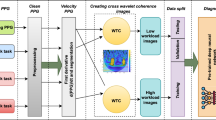Abstract
A novel tool of bio signal processing is proposed to identify human muscle action through sEMG. The tool is based on Integration of continuous wavelet transforms, wavelet time entropy and wavelet frequency entropy to identify muscle actions through sEMG. The experiments are carried out on triceps, biceps and flexor digitorum superficial (FDS) muscles. sEMG signals are measured at different intensities of FDS muscle contractions in order to verify the consistency of results. By taking the average entropies and based on lowest average wavelet entropy, it is found in calibrated experiment that complex Shannon wavelet family is the best candidate to identify the muscle activities among: Derivative of Gaussians wavelet family, Derivative of Complex Gaussians wavelet family, Complex Morlet family, Symlets, Coiflets and Daubechies wavelet families. Moreover, the results are consistent over the time-variant signal. The results presented in this paper have futuristic engineering implication in biomedical engineering and bio-robotic applications.
















Similar content being viewed by others
References
Addison P (2002) The Illustrated Wavelet Transform Handbook. Taylor & Francis Group, New York, London
Alsberg BK, Kell DB, Woodward AM (1997) An introduction to wavelet transforms for chemometricians. A time-frequency approach. Chemom Intell Lab Syst 37:215–239
Castellini C, Fiorilla AE, Sandini G (2009) Multi-subject/daily-life activity EMG-based control of mechanical hands. J Neuro Eng Rehabil 6(41). doi:10.1186/1743-0003-6-41
Chen F, Zhang YT (2005) A new implementation of discrete bionic wavelet transform: adaptive tiling. Digit Signal Process 16(3):233–246
Daubechies I (1991) Ten lectures on wavelets, CBMS–NSF Series in Applied Mathematics (SIAM)
de Luca CJ (2008) Imaging the behavior of motor units by decomposition of the EMG signal, Delsys Inc., ISBN: 978-0-9798644-0-7, Boston
De Luca CJ (2008) Practicum on the use of surface EMG signals in movement sciences, (vo1 5), Delsys Inc., ISBN: 978-0-9798644-0-7, Boston
De Luca CJ, Adam A, Wotiz R, Gilmore LD, Nawab SH (2006) Decomposition of surface EMG signals. J Neurophysiol 96:1646–1657
Enoka RM, Stuart DG (1984) Henneman’s ‘size principle’: current issues. Trends Neurosci 7(24):226–228
Ismail AR, Asfour SS (1998) Continuous wavelet transforms application to EMG signals during human gait. In: Conference record of the 32nd Asilomar conference on signals. Syst Comput vol 1, pp 325–329
Lau K-M, Wcng H-Y (1995) Climate signal detection using wavelet transform: how to make a time series sing. Bull Am Meteo Soc 76(12):2391
Lee KW, He T, Ilhan HT, Linscott I, Olgin JE (2005) Feature extraction of the atrial fibrillation signal using the continuous wavelet transform. In: 26th Annual international conference of the IEEE engineering in medicine and biology society, pp 275–278
Mallat SG (1998) A wavelet tour of signal processing. Academic Press, San Diego, London, Boston, New York, Sydney, Tokyo, Toronto
Mishra AK, özger M, Singh VP (2009) An entropy-based investigation into the variability of precipitation. J Hydrol 370(1–4):139–154
Nurco DJ, Conklin DE, Shapiro NS (2009) Motor unit recruitment strategies during deep muscle pain. WordPress.http://natchem.wordpress.com/2009/11/23/motor-unit-recruitment-strategies-during-deep-muscle-pain/
Rafiee J, Schoen MP, Prause N, Urfer A, Rafiee AM (2009) A comparison of forearm EMG and psychophysical EEG signals using statistical signal processing. In: 2nd International conference on computer, control and communication
Rajagopalan V, Ray A (2006) Symbolic time series analysis via wavelet-based partitioning. Signal Process 86(11):3309–3320
Scheper RA, Teolis A (2003) Cramer-Rao bounds for wavelet transform-based instantaneous frequency estimates. IEEE Trans Signal Process 51:1593–1602
Teolis A (1998) Computational signal processing with wavelets. Birkhäuser, Boston
Torrence C, Compo GP (1998) A practical guide to wavelet analysis. Bull Am Meteorol Soc 79:61–78
Von Tscharner V (2000) Intensity analysis in time–frequency space of surface myoelectric signals by wavelets of specified resolution. J Electromyogr Kinesiol 10:433–445
Winter DA (2009) Biomechanics and motor control of human movement. Wiley, Hoboken
Xie XP, Ding XH (2009) Gene expression pattern extraction based on wavelet analysis. In: International conference on information and automation, pp 1274–1278
Zhengyou HXC, Qingquan Q (2007) A Study of wavelet entropy measure and definition and its application for fault feature pick-up and classification. J Electron 24(5):628–634. doi:10.1007/s11767-005-0253-0
Zheng-You H, Xiaoqing C, Guoming L (2006) Wavelet entropy measure definition and its application for transmission line fault detection and identification. In: Proceedings of the 2006 international conference on powersystem technology, pp 1–6
Acknowledgments
Authors would like to thank Dr Steven Brown and Simon Bennett for their help in neuromuscular system clarification and laboratory setup. Also, I would like to thank Dr Carlo Laing for his help in mathematical aspects of my research.
Author information
Authors and Affiliations
Corresponding author
Rights and permissions
About this article
Cite this article
Almanji, A., Chang, JY. Feature extraction of surface electromyography signals with continuous wavelet entropy transform. Microsyst Technol 17, 1187–1196 (2011). https://doi.org/10.1007/s00542-010-1180-z
Received:
Accepted:
Published:
Issue Date:
DOI: https://doi.org/10.1007/s00542-010-1180-z




